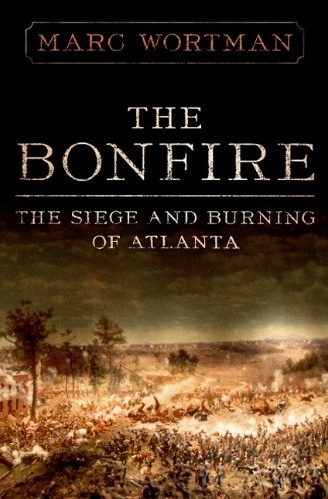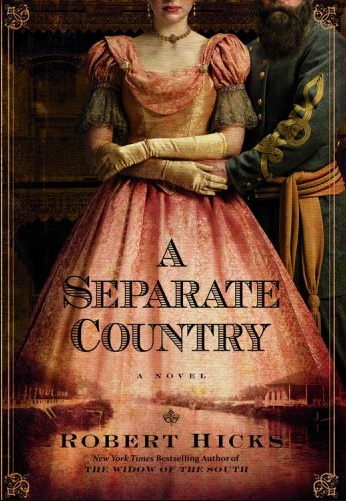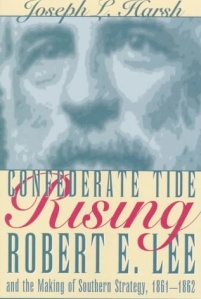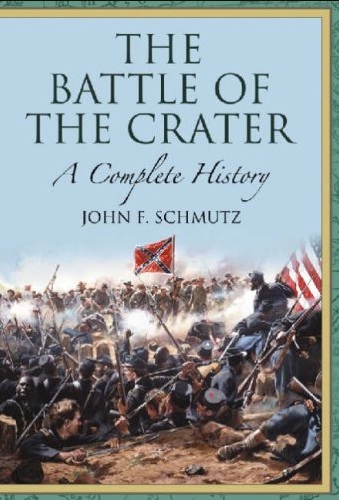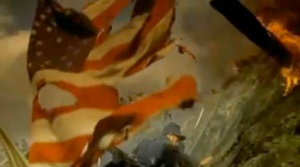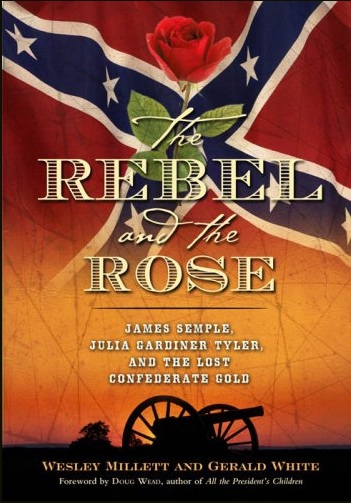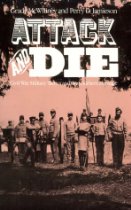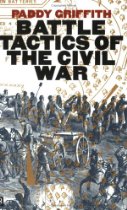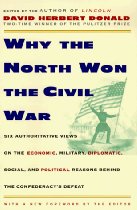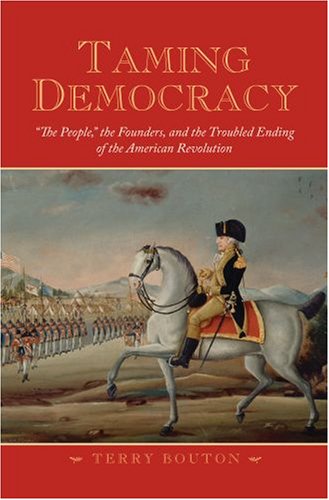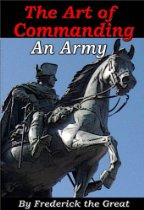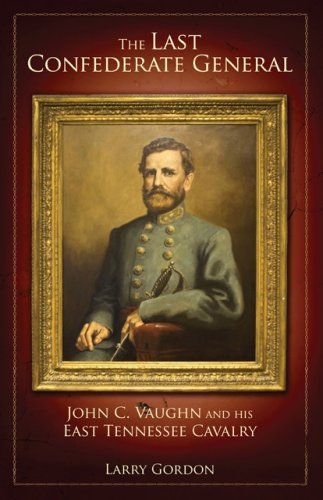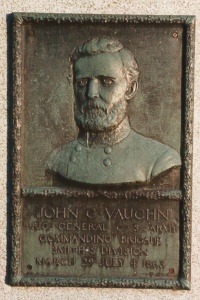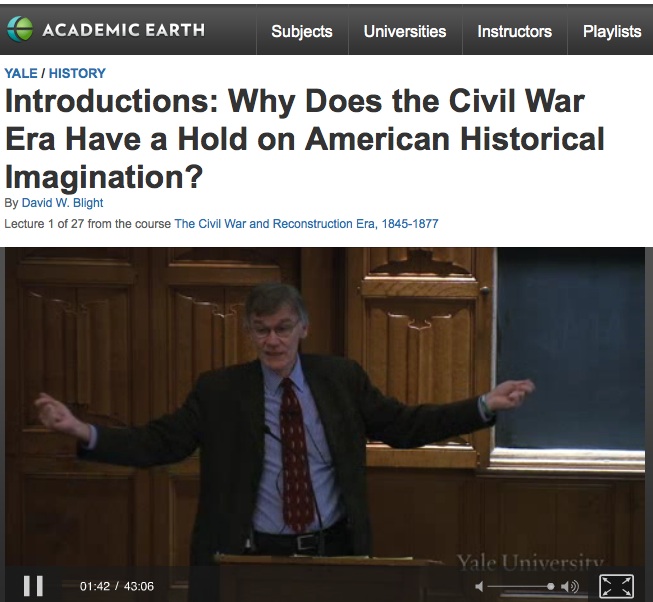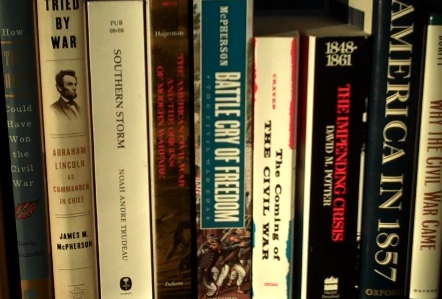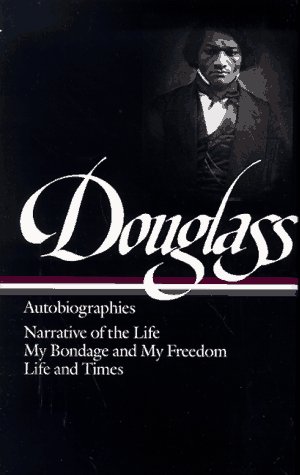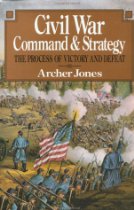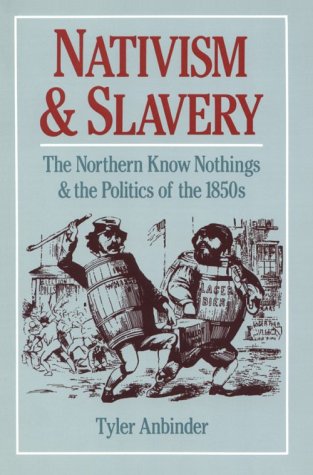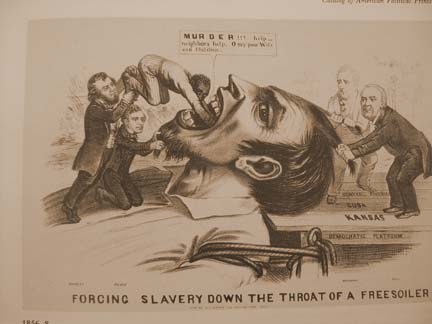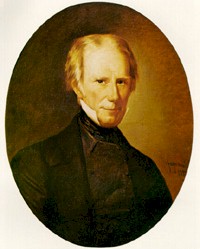Archive for the ‘Books’ Category
On Braxton Bragg – 1
W. J. Wood called Braxton Bragg the “most complicated of all the Confederacy’s generals.”(1) A graduate of the academy, where he excelled, he displayed skills as an administrator and adept trainer of troops. He had seen action in the Mexican War and was heralded as a war hero for his actions commanding artillery during the Battle of Buena Vista. Bragg was a stern disciplinarian, which Wood attributes to his experiences in Mexico where volunteer units ran when under fire from the enemy. He could be brusque even to the point of being rude.(2) He also shared his opinions freely, often too freely.

Library of Congress: Battle of Buena Vista, fought Feb. 23rd, 1847. Lithograph by N. Currier, 1847. Reproduction number: LC-USZC4-2957
(1) W. J. Wood, Civil War Generalship: The Art of Command [book on-line] (Westport, CT: Praeger Publishers, 1997, accessed 29 November 2009), 118; available from Questia, http://www.questia.com/PM.qst?a=o&d=30549970; Internet.
New in Paperback – This Mighty Scourge: Perspectives on the Civil War
The good folks at Oxford University Press recently sent me a copy of the new paperback edition of James McPherson’s This Mighty Scourge: Perspectives on the Civil War. First published in 2007, it comprises 16 essays in which McPherson attempts to answer the following questions:
- Why did the war come?
- What were the war aims of each side?
- What strategies did they employee to achieve these aims?
- How do we evaluate the leadership of both sides?
- Did the war’s outcome justify the immense sacrifice of lives?
- What impact did the experience of war have on the people who lived through it?
- How did later generations remember and commemorate that experience?
- Author: James M. McPherson
- Publisher: Oxford University Press
- ISBN13: 9780195392425
- ISBN10: 0195392426
- Paperback, 272 pages
- Sep 2009
I read the hardback version in 2007 and can highly RECOMMEND.
FYI – Amazon has the paperback version available for here for $12.21.
New Acquisition – Supreme Command: Soldiers, Statesmen, and Leadership in Wartime
![]() I’ve made a number of new acquisitions over the past few weeks. I bought this book to assist with an assignment on the command skills of Abraham Lincoln. Author Eliot A. Cohen (left), also examines the records of Georges Clemenceau, Winston Churchill and David Ben-Gurion in an effort to synthesize why they stand above others as leaders in time of war. So far, after reading the first few chapters, I’m quite impressed. Full disclosure: I own the 2002 paperback version of this book published in the UK by The Free Press. I recently purchased the audio version from Audible.com published by Blackstone Audiobooks and narrated by Robert Whitfield (a.k.a. Simon Vance).
I’ve made a number of new acquisitions over the past few weeks. I bought this book to assist with an assignment on the command skills of Abraham Lincoln. Author Eliot A. Cohen (left), also examines the records of Georges Clemenceau, Winston Churchill and David Ben-Gurion in an effort to synthesize why they stand above others as leaders in time of war. So far, after reading the first few chapters, I’m quite impressed. Full disclosure: I own the 2002 paperback version of this book published in the UK by The Free Press. I recently purchased the audio version from Audible.com published by Blackstone Audiobooks and narrated by Robert Whitfield (a.k.a. Simon Vance).
- Author: Eliot A. Cohen
- Published: 2003-09-09
- Publisher: Anchor
- ISBN13: 9781400034048
- Binding: Paperback
- 320 pages
National Geographic’s New Atlas of the Civil War
- Hardcover: 256 pages
- Publisher: National Geographic (October 20, 2009)
- Language: English
- ISBN-10: 1426203470
- ISBN-13: 978-1426203473
- Product Dimensions: 13.7 x 10.7 x 1.1 inches
The good folks at National Geographic sent me a review copy of their new Atlas of the Civil War: A Comprehensive Guide to the Tactics and the Terrain of Battle. I’m impressed. This is one of those books that as a kid I would spread out on the floor in front of the fire and lose myself in for hours. It’s FULL size means just that. Images that many of us have seen for years, and many we’ve never seen, are spread across pages over a foot high. So when looking at the bloated bodies of dead warriors near the Peach Orchard of Gettysburg’s Battlefield, it becomes immediately obvious that none have shoes, scavengers having carried them away.
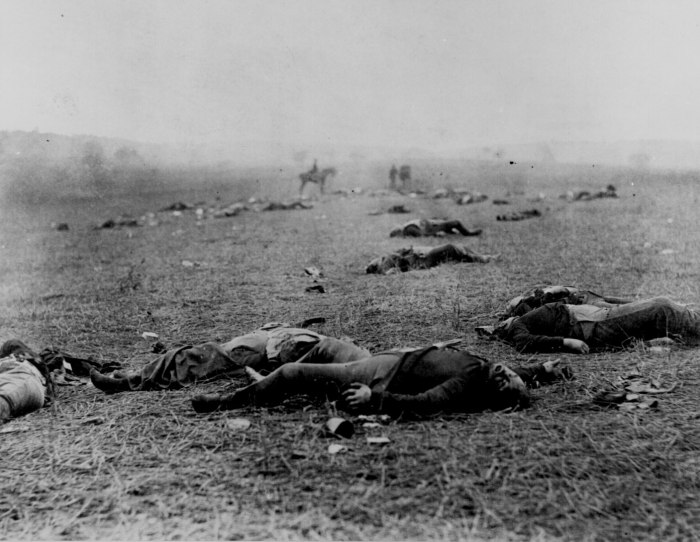
Union and Confederate dead, Gettysburg Battlefield, Pa., July 1863. Photographed by Timothy H. O'Sullivan. 165-SB-36. National Archives
Plainly visible among the troops and civilians crowded inside the walls of Washington’s Old Penitentiary on July 7, 1865 (below) to witness the hanging of Lincoln assassination conspirators, is a young boy, apparently unable to turn away from the gallows.
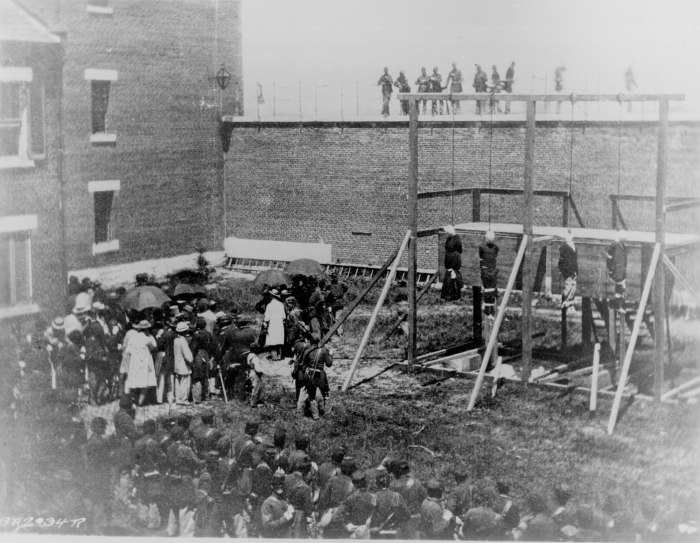
Execution of the four persons condemned as co-conspirators in Lincoln's assassination, July 7,1865. Photographed by Alexander Gardner. 111-BA-203 National Archives
But even more impressive are the maps. There are 88 rare period maps, many published for the first time, and 34 new maps created by the staff of the National Geographic’s cartographers led by Carl Mehler. All are in a large format which makes them entirely readable. Almost a dozen orders of battle are also provided along with biographies and timelines.
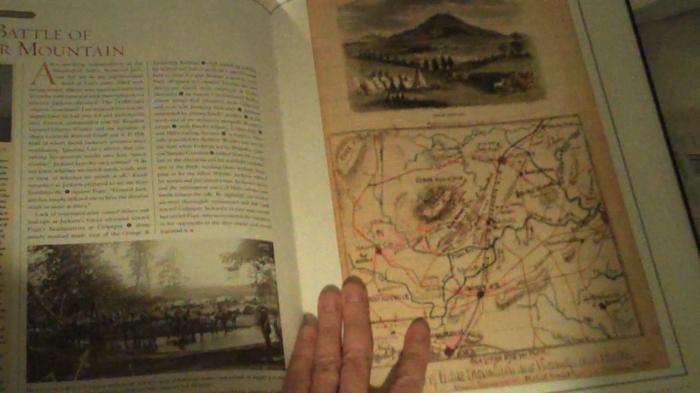
Editor Neil Kagan and historians Stephan G. Hyslop and Harris J. Andrews, who also collaborated on National Geographic’s Eyewitness to the Civil War, have provided excellent commentary and a rich story of the war from beginning to end. Carol Norton, as art director, led the creative vision for what is really a quite remarkable book of art.
I say BRAVO. Highly recommend.
Book Review: Jefferson Davis and His Generals – The Failure of Confederate Command in the West
STEVEN E. WOODWORTH. Jefferson Davis and His Generals: The Failure of Confederate Command in the West. Lawrence, Kansas: University Press of Kansas. 1990. Pp. xv, 380. $16.95.
Much has been written about the political and military genius of Abraham Lincoln and the successful leader he grew to be while Commander in Chief of a fractured union. But as the country divided and civil war became a reality, a new leader was called upon to assume the role of Commander in Chief for the Confederacy, the seasoned Jefferson Davis. At the precipice of war, betting men looking at the comparative qualifications of the two presidents could easily have predicted that Davis would outshine Lincoln. What kind of leader did Davis prove to be and how did he recruit and manage those men who would become members of his high command? What kind of generals were they and how did their personalities and actions impact the outcome of the war?
Steven E. Woodworth’s monograph answers those questions and others through examination of Jefferson Davis’ handling of the generals who defended the newly formed Confederacy in the Western theater of the American Civil War. Against a chronology of key events, each commander is introduced with information essential to understanding the skills they brought to war. Woodworth gives us their respective birthplaces, education, military and political experience, and reasons for consideration as senior leaders. Their performances in command roles are examined along with their interactions with Davis. There is brilliance to be sure from both Davis and some of his generals. But there is also incompetence, jealousy, loss of nerve, and even a propensity toward sabotage of brother commanders. Varying degrees of analysis are given to among others: Leonidas Polk, Simon Bolivar Buckner, Albert Sidney Johnston, P.G.T. Beauregard, Braxton Bragg, Early Van Dorn, John C. Breckenridge, Edmund K. Smith, Nathan Bedford Forrest, Patrick R. Cleburne, Sterling Price, William J. Hardee, John C. Pemberton, Joseph E. Johnston, Benjamin F. Cheatham, James A. Seddon, Daniel H. Hill, James Longstreet, Gideon J. Pillow, David Twiggs, and John Bell Hood. Woodworth pulls no punches.
Woodworth concludes that Davis was highly trained, skilled from a breadth of experience in the militarily and in politics, and eminently qualified to assume the role of Commander in Chief of the Confederacy. He was also flawed. His imperfections are revealed as the war in the West is traced from beginning to end. Davis is shown to be incapable of judging objectively the performances of personal friends. He both trusts and delegates too much to his leaders. This trait worked to the detriment of some of the most exceptional men like Albert Sidney Johnston, who accomplished miracles in the defense of western borders despite unanswered requests to fill and equip his ranks. It also left incompetents like Leonidas Polk in power, impairing more talented men like Braxton Bragg. Davis becomes consumed by the war emotionally and physically. In the end, failure in the West is seen to have contributed significantly to the failure of the Confederacy. Woodworth posits that the faults of Davis himself, stemming from a deep-seated insecurity, are contributory to this failure.

Woodworth brings to the work the credentials of a seasoned historian. He holds history degrees from Southern Illinois University (B.A. 1982) and Rice University, where he received a Ph.D. in 1987. At the time of the book’s publication, he taught history at Toccoa Falls College in Georgia. He now teaches U.S. history, Civil War and Reconstruction, and the Old South at Texas Christian University. He also teaches military history at the American Military University. He is a prolific and award winning author.
Woodworth provides an insightful contribution to our understanding of the Civil War by revealing the best and the worst of the Confederacy’s senior military leadership in the West.
Particularly helpful to an understanding of the challenges faced by Davis’ high command is Woodworth’s campaign analysis. Also exemplary is the concise summary he provides of key points at the end of each chapter. This important study in leadership fills a gap and stands equal to and complementary of the T. Harry William classic, Lincoln and His Generals. It is both highly readable and academically rich.
The War of 1812 in the Age of Napoleon by Jeremy Black
The good folks at the University of Oklahoma Press forwarded a review copy of Jeremy Black’s new book, The War of 1812 in the Age of Napoleon. In my usual fashion, I am making an initial post about the book before a full reading.
ISBN: 978-0-8061-4078-0
Hardcover
288 pages
6″ x 9″ x 0″
1 B&W Illus., 3 Maps
Published: 2009, Oklahoma University Press

Jeremy Black (Photo: athens.edu)
The quick perusal reveals several compelling reasons for recommending the book. First, it is written from “an Atlantic vantage point, which accounts for its contribution to the academic coverage of the war as the latter tend to reflect national perspectives, mostly American, but also Canadian.” (Black, xiv) It goes without saying that any serious scholar of military history would seek out the work of historians and indeed primary sources providing insights from a variety of vantage points. Second, Black speaks to the impact of the war not only on America but also on Canada. Black speculates on how the history of the United States would have been very different had it expanded into Canada, “not the least because the slave states of the South would have been in a decided minority.” (Black, xii) Third, Black covers the naval operations so crucial to the war’s outcome. Fourth, the books addresses the consequences of the war. Black discusses the war’s “impact on America’s politics, public culture, economy, and territorial expansion” as being even more important than the military results. (Black, xiii) Finally, the book promises to explore the implications of unwanted expeditionary war, a topic with relevancy today.
Professor Black’s new book is Volume 21 in the Campaigns and Commanders Series. Black, a prolific writer, has authored more than seventy (70) books. He is Professor of History at the University of Exeter and a senior fellow at the Center for the Study of America and the West at the Foreign Policy Research Institute in Philadelphia. He has lectured extensively around the world.
The Campaigns and Commanders Series at the University of Oklahoma Press include the following:
| Title | Volume | Author(s) | |
| The War of 1812 in the Age of Napoleon | 21 | By Jeremy Black | |
| A Dragon’s Head and a Serpent’s Tail | 20 | By Kenneth M. Swope | |
| With Zeal and with Bayonets Only | 19 | Matthew H. Spring | |
| Once Upon a Time in War | 18 | Robert E. Humphrey | |
| Borrowed Soldiers | 17 | Mitchell A. Yockelson; | |
| The Far Reaches of Empire | 16 | John Grenier | |
| Napoleon’s Enfant Terrible | 15 | John G. Gallaher | |
| Three Days in the Shenandoah | 14 | Gary Ecelbarger | |
| George Thomas | 13 | Christopher J. Einolf | |
| Volunteers on the Veld | 12 | Stephen M. Miller | |
| The Black Hawk War of 1832 | 10 | Patrick J. Jung | |
| William Harding Carter and the American Army | 9 | Ronald G. Machoian | |
| Blood in the Argonne | 8 | Alan D Gaff | |
| Blue Water Creek and the First Sioux War, 1854-1856 | 6 | R. Eli Paul | |
| The Uncivil War | 5 | Robert R. Mackey | |
| Bayonets in the Wilderness | 4 | Alan D Gaff | |
| Washita | 3 | Jerome A. Greene | |
| Morning Star Dawn | 2 | Jerome A. Greene | |
| Napoleon and Berlin | 1 | Michael V. Leggiere |
National Book Awards Finalists
The National Book Awards finalists have been named.
And here are your finalists for the Non-Fiction category…
![]() .
.
Congratulations to the authors and publishers!
I’ve got my eye on the The First Tycoon: The Epic Life of Cornelius Vanderbilt.
Jayhawkers: The Civil War Brigade of James Henry Lane
ISBN: 978-0-8061-3999-9
Cloth
352 pages
12 b&w illus., 1 map
Published: 2009-04-30
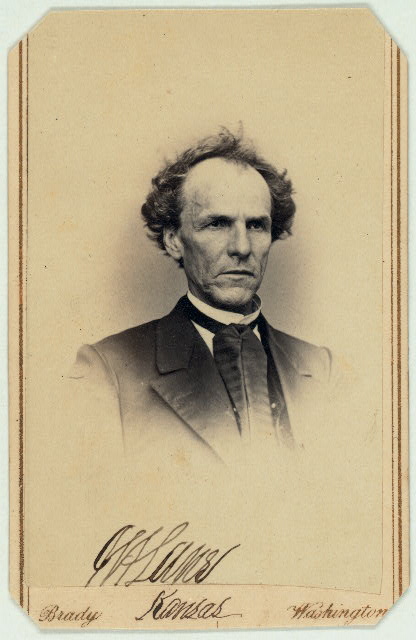
Carte d' visite of James Henry Lane, 1814-1866 Photographer: Brady National Photographic Art Gallery (Washington, D.C.) Library of Congress, Reproduction Number: LC-MSS-44297-33-037 (b&w negative)
The good folks at the University of Oklahoma Press sent me a review copy yesterday of Bryce Benedict’s Jayhawkers: The Civil War Brigade of James Henry Lane. In my usual fashion, I’m posting a few comments prior to a thorough reading.
I live on the borders of Missouri and Kansas so confess some considerable fascination with both Jim Lane and the evolution of war in the towns and farmlands of this part of the Western theater. Lane, a Kansas senator and strong advocate of Lincoln, was a player. Benedict identifies Lincoln himself as having given Lane authority “to raise and command two volunteer regiments.” Lane used them to harass Missourians with violence, theft, and destruction of property in a manner foreshadowing that of Sherman. Benedict posits that Lane thus embraced the notion of “total war” as a means of disabling the enemy’s war machine before it became more widely adopted as a strategy of the Union.
The photo of Lane on the cover (above) was a brilliant choice. After perusing the Library of Congress and finding his carte d’visite (left), it becomes clear that the look of the man fit his personality. In the words of Milton W. Reynolds, Lane was “weird, mysterious, partially insane, partially inspired, and poetic.” He described him as having lived a “…wayward, fitful life of passion and strife, of storm and sunshine a mysterious existence that now dwelt on the mountain-tops of expectation and the very summit of highest realization, and anon in the valley of despondency and deepest gloom.” [1] Lane committed suicide by shooting himself in the mouth with a pistol in 1866.
Author Bryce Benedict has produced a well researched work with notes for each chapter and three appendices including considerable information about fate of the casualties of Lane’s brigade, most of whom died from disease.
—–
For further reading, check out these books digitized for online reading at the Library of Congress.
[1] Connelley, William Elsey, (1855-1930) James Henry Lane, the “Grim chieftain” of Kansas (Topeka: Crane, 1899). The Library of Congress Digitized Book. LOC Call number: 9594581, Digitizing sponsor: Sloan Foundation
New Acquisition – The Complete Gettysburg Guide
I made a number of new acquisitions over the past month. The latest arrived in the mail today and has been added to my virtual bookshelves here. I’m actually pretty excited by this purchase.
![]() .
.
The Complete Gettysburg Guide: Walking and Driving Tours of the Battlefield, Town, Cemeteries, Field Hospital Sites, and other Topics of Historical Interest
Format: Hardcover
Price: $39.95
ISBN: 978-1-932714-63-0
Published: 2009-06-01 by Savas Beatie
Language: English
Binding: Hardcover
Pages: 320
Dimensions: 7 X 10
Petruzzi
J. David Petruzzi (Author) who blogs at Hoofbeats and Cold Steel here.
Stanley
and Steven Stanley (Maps and Photography) 62 photos and 70 full color maps
Hunting Books for Independent Study … Civil War Naval History
I’m exploring options for topics for an independent study course. This one is floating to the top of what I’d like to study. Any other books my readers might suggest are welcome.
Naval Operations of the American Civil War
Reading Pace: 1 book or equivalent primary sources per week or two weeks depending on length (max 16)
Course Evaluation: Book Review for each book read and Final essay
Beginning Reading List (Not complete and to be agreed on with professor):
Bennett, Michael J. Union Jacks: Yankee Sailors in the Civil War. Chapel Hill: University of North Carolina Press, 2004.
Brooksher, William R. War Along the Bayou: The 1864 Red River Campaign in Louisiana. Washington: Brassey’s, 1998.
Chaffin, Tom The H. L. Hunley (Hill and Wang, 2008)
Forsyth, Michael J. The Red River Campiagn of 1864 and the Loss by the Confederacy of the Civil War, Jefferson, NC: McFarland, 2002.
Friend, Jack. West Wind, Flood Tide: The Battle of Mobile Bay. Annapolis: Naval Institute Press, 2004.
Joiner, Gary D. One Damn Blunder from Beginning to End: The Red River Campaign of 1864. Wilmington, DE: Scholarly Resources, 2003.
Lewis, Charles Lee. David Glasgow Farragut: Our First Admirial. 2 vols. Annapolis: Naval Institute Press, 1943.
Merli, Frank J. Great Britain and the Confederate Navy, 1861 – 1865 (Indiana University Press, 2004)
—-, The Alabama, British Neutrality, and the American Civil War (Indiana University Press, 2004)
Symonds, Craig L. Confederate Admiral: The Life and Wars of Franklin Buchanan. Annapolis: Naval Institute Press, 1999.
—-,Lincoln and His Admirals (Oxford University Press, 2008)
Tucker, Spencer C. Andrew Foote: Cvivil War Admiral on Western Waters. Annapolis: Naval Institute Press, 2000.
Valuska, David L. The African American in the Union Navy: 1861-1865. New York: Garland, 1993.
Weddle, Kevin. Lincoln’s Tragic Admiral: The Life of Samuel Francis Du Pont, Charlottesville: Universtiy of Virginia Press, 2005.
The Bonfire: The Siege and Burning of Atlanta
The Bonfire: The Siege and Burning of Atlanta
Marc Wortman
ISBN 978-1-58648-482-8
Pub date: 08/11/09
Price: $28.95/36.50 Canada
6 1/8 x 9 1/4
464 pages
The good folks at PublicAffairs Books sent me a review copy of Marc Wortman’s The Bonfire: The Siege and Burning of Atlanta viewable on my virtual bookshelves here. I decided to create a shelf specific to “Civil War Sieges” because this book doesn’t quite fit in other categories. That uniqueness is part of its draw.
Full disclosure: This is my usual “pre-read” post where I’ll share some early impressions. Wortman had me before page one because he put six nicely done maps right up front. His poignant introduction left me with no recourse but to read on. A small excerpt:
War is cruelty. Its bloodshed and destruction – the “hard hand of war,” as Sherman really did call it – struck Atlanta with a greater ferocity than it has any American city in history. This is the story of how Atlanta and its people came to be in the direct line of the whirlwind, what one of the besieged city’s Confederate defenders called “a grand holocaust of death.” (Wortman, 2)
Having read the first chapter, I can say that Wortman has a talent for turning a phrase. His depiction of a devastated Atlanta on the morning of September 2, 1864 put me there.
A reeking sulfurous stew that stung the eyes had already settled over the town, filling the railroad cuts, hollows, and streets. Its tendrils wavered along the hillsides and ravines and sifted through the blackened skeletons of what once were houses and factories, railcars and machine shops. It was the silence, though, that shocked people most. Three predawn hours of gut-rattling, earsplitting, and window-shattering explosions and gunfire made the previous night feel like the announcement that the Apocalypse had finally come. But the infernal noise had ended shortly before morning’s light tipped into the eyes of those hunkered down within the earth. (Wortman, 5)
From reading just a few chapters of book, its TOC, and its index, I can add that Wortman’s work emphasizes the broader historical context of the war, covers the importance of railroads during the Civil War, provides insights into the conflict as seen from the perspectives of common soldiers and citizens, and draws upon a substantial amount of primary sources. All of these are pluses.
I look forward to a thorough reading.
Author Marc Wortman, see his website here, is a freelance journalist of some acclaim. He received his doctorate in Comparative Literature from Princeton University.
An earlier book published by PublicAffairs Books in May of 2007, The Millionaires’ Unit: The Aristocratic Flyboys Who Fought the Great War and Invented American Air Power, also looks like a great read and I recently ordered a copy. Per the publisher, it is in development as a major motion picture. Of note, both of Wortman’s histories are available in Kindle versions which means you can begin reading them in about 40 seconds.
A Separate Country
![]() The good folks at Hachette Book Group USA sent me a review copy of Robert Hicks’ A Separate Country. A follow up to the bestseller, The Widow of the South, which hit the New York Times Best Seller List, this new title will be available in bookstores on September 23rd. Multiple versions will be available including electronic and audio (unabridged). You can preview the book here.
The good folks at Hachette Book Group USA sent me a review copy of Robert Hicks’ A Separate Country. A follow up to the bestseller, The Widow of the South, which hit the New York Times Best Seller List, this new title will be available in bookstores on September 23rd. Multiple versions will be available including electronic and audio (unabridged). You can preview the book here.
![]() .
.
- Category: FICTION
- Format: HARDCOVER BOOK
- Publish Date: 9/23/2009
- Price: $25.99/$31.99
- ISBN: 9780446581646
- Pages: 432
- Size: 6″ x 9
It’s subject is the ever fascinating Confederate General John Bell Hood and his life after the war with wife, Anna Marie Hennen (see her obit here). You can read excerpts of Hood’s memoir, Advance and Retreat here.
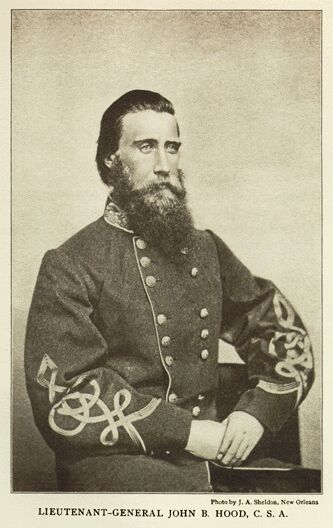
Books for class arrive! Civil War Command and Leadership
Ah… the “ding dong” of the door and the Amazon boxes thump against the door. Love it.
Full disclosure…I had to get some of these from resellers.
Here’s the stack.
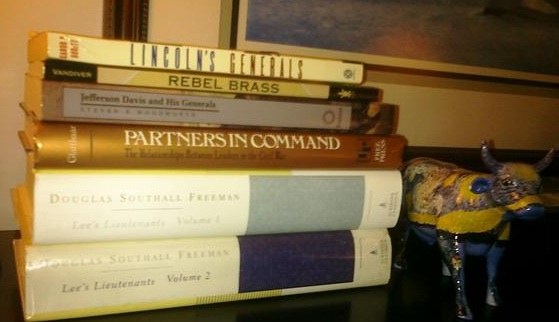
Note I bought the full three volume version of Lee’s Lieutenants (Vol 3 not pictured here). All books on the list can be seen on my virtual bookshelves here.
For more on my upcoming class, see the post below or “the courses” page here.
Stephen Woodworth to Teach Civil War Command and Leadership
Free Copy of Harsh’s Confederate Tide Rising
UPDATE ALERT: The book was snapped up within minutes of this post. Thanks to everyone who inquired.
—-
I recently ordered a “Like New” copy of Joseph L. Harsh’s Confederate Tide Rising: Robert E. Lee and the Making of Strategy, 1861 – 1862 to round out my set of his series. It came damaged in the post in part because the shipper packed it poorly (no padding). He has kindly offering to replace the book. I would be delighted to provide the damaged copy to anyone who would care to pay for the shipping. The pages of the book are in excellent shape and clearly new/unread. The damage is a scrape/bend to the cover and an associated rip of the book jacket. The dent slightly effects the first 10 pages of the book. Please contact me at renetyree at gmail.com. First-come-first-served.
The Battle of the Crater: A Complete History
- Title: The Battle of the Crater: A Complete History
- Author: John F. Schmutz
- Published on: 2009-01-19, McFarland & Company, Inc., Publishers
- Binding: Hardcover
- 428 pages
- ISBN-10: 0786439823
- ISBN-13: 978-078643982
I have happily received a review copy of John F. Schmutz’s The Battle of the Crater: A Complete History. I can be counted among those whose interest in this remarkable 9 hour battle was piqued after watching the mesmerizing opening sequence of the film based on Charles Frazier’s Cold Mountain.
It would be hard to find a similar military event in history that paralleled this one in terms of overwhelming potential for success run amok. Schmutz’s use of an opening quote about the July 30, 1864 battle by Ulysses S. Grant perhaps says it best…
The loss in the disaster of Saturday last foots up about 3,500, of whom 450 men were killed and 2,000 wounded. It was the saddest affair I have ever witnessed in the war. Such an opportunity for carrying fortifications I have never seen and do not expect again to have.
– Lieutenant General Ulysses S. Grant to Major General
Henry W. Halleck, August 1, 1864.
According to Schmutz, his interest in the Battle of the Crater began with the discovery that he had “two direct ancestors in the battle, one with the 14th New York Heavy Artillery, which at the last minute, and without any preparation or forewarning, was chosen to lead the assault, with disastrous consequences.” (Preface) This seed germinated into one of the first studies to take a broad-brush approach to the battle, examining the events leading up to it, the country’s mood in its now third year of civil war, brutality committed against black troops, atrocities perpetrated by both sides, first-hand accounts, and the impact of the battle “on the body politic of both sides.”
Schmutz appropriately gives readers a sense for war in the trenches that were part of the Siege of Petersburg.
As both sides dug even deeper entrenchments and more infantry obstacles, the rolling farmland east and south of the city was soon churned into scenes resembling a moonscape. These tandem ramparts ran for twenty-six miles, crossed two major rivers, and traversed parts of four Virginia countries, from White Oak Swamp, east of Richmond, across Bermuda Hundred and south of the Jerusalem Plank Road below the city. No campaign of the war quite equaled the siege of Petersburg, which was the object of the longest military action ever waged against an American city. More battles were fought and more lives lost there than in the defense of any better-known Southern cities such as Richmond, Vicksburg or Atlanta. (p. 40)
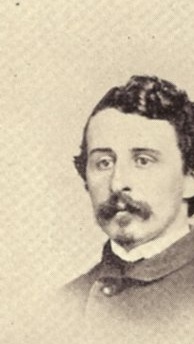
Henry Pleasants
The excellent chapter titled “The Earth Movers,” reveals how Lt. Col. Henry Pleasants and the men of the 48th Pennsylvania, many of them coal miners, accomplished what Meade’s engineers mockingly called impossible, the building of a lengthy tunnel without detection by the Confederates. Receiving literally no support from Meade or his men, Pleasants overcame every challenge with ingenuity and innovation. As an example, he used a combination of miner’s bellows and fire to create draft to circulate air through a shaft built into the tunnel wall. This bit of creative thinking, the details of which are a must read, became what Schmutz called Pleasants’ “greatest engineering feat.” (p. 61)
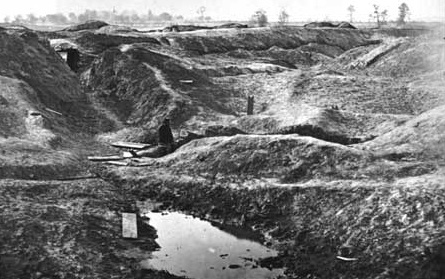
From the National Park Service site on the Petersburg National Battlefield, "The Crater as it appeared in 1865. The Union soldier seated at the end of the tunnel gives an idea of the size of the Crater." Click the image to go to the site.
Of note, Schmutz provides an impressive set of references in his appendices, something I always value in a book of serious history. These include:
- Organization of Opposing Forces on July 30, 1864 including Union and Confederate Corps, Division, and Brigade, and in some cases Company commanders and officers
- Casualty counts by Corps, Division, Brigade and Unit
- Medal of Honor Recipients and Confederate Roll of Honor Recipients by Corps including a brief statement about why they received the award
Union Officers Killed or Mortally Wounded by Corps, Division, and Brigade - Full and extensive Chapter Notes
- An impressive Bibliography which demonstrates the extent of primary sources used in Schumtz’s research
I greatly look forward to fully reading this book and fully expect that a Highly Recommend will be forthcoming.
Kevin Levin has recently provided a review of The Battle of the Crater: A Complete History on H-Net here.
Stephen Woodworth to Teach Civil War Command and Leadership
I just registered for my next course: Civil War Command and Leadership. Here’s a quick summary: “a study of national, theater, and operational command structures of the Union and Confederacy, the leadership styles of key military leaders on both sides, and the evolution of command and control in the war. Major themes include the relationship between the commanders in chief and the generals who led the armies in the field, the relationships between the generals themselves, and the ways in which the relationships described above either served to facilitate or debilitate the causes those commanders served.”
I am VERY excited about the professor, Steven E. Woodworth!

- Ph.D., Rice University, 1987
- Professor of history at Texas Christian University
- Author, co-author, or editor of twenty-seven books you can view here
- Two-time winner of the Fletcher Pratt Award of the New York Civil War Round Table (for Jefferson Davis and His Generals and Davis and Lee at War)
- Two-time finalist for the Peter Seaborg Award of the George Tyler Moore Center for the Study of the Civil War (for While God Is Marching On and Nothing but Victory)
- Winner of the Grady McWhiney Award of the Dallas Civil War Round Table for lifetime contribution to the study of Civil War history
I’ve added a new page on my bookshelves to show the booklist for the course as it stands today which you can access here.
The Rebel and the Rose
I was pleased to recently receive a review copy of the book The Rebel and the Rose: James Semple, Julia Gardiner Tyler, and the Lost Confederate Gold. Its authors, Wesley Millett and Gerald White, are profiled on the book’s attractive website here. The book is currently published by Turner Publishing Company.
It promises insight into several interesting topics:
- the flight of Jefferson Davis at war’s end
- the disappearance of the Confederate war chest
- a romantic liaison with presidential ties
More to come…
More Debate on The State of Jones and Interview with John Stauffer
–
A quick break from the books to tip the hat to Elektra Tig for Tweet on John Stauffer interview here on the Omnivoracious blog about his book, The State of Jones.
The book continues to generate debate.
The Wall Street Journal posted a chapter in their books section here and Michael B. Ballard’s review of the book appears in the WSJ here. Authors Sally Jenkins and John Stauffer provide a response/rebuttal to that review on July 17th in an article titled “The State of Jones Was Real, and Ahead of Its Time” available here. The debate continues to be fascinating.
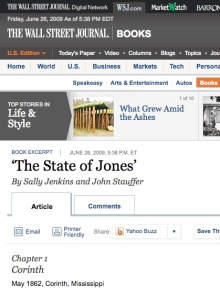
OK back to Taken at the Flood.
Up this week: Taken at the Flood
I’m thrilled to be finally reading Taken at the Flood: Robert E. Lee and the Confederate Strategy in the Maryland Campaign of 1862. Clearly I must obtain copies of the other books in this series.
Book Review: Lincoln and His Generals
 T. HARRY WILLIAMS. Lincoln and His Generals. New York: Random House, 1952. Pp. viii, 363, $2.40.
T. HARRY WILLIAMS. Lincoln and His Generals. New York: Random House, 1952. Pp. viii, 363, $2.40.

T. Harry Williams
Over half a century ago, T. Harry Williams wrote an exceptional work with as major theme that the performance of President Abraham Lincoln as commander in chief during the American Civil War positioning him as the true director of the war efforts of Northern armies and the progenitor of the country’s first modern command system. He shows Lincoln to be an able student of military strategy who ramped up quickly, grasped the end game and generally how to reach it, but struggled to find the right executioner of those plans. That he was even more skilled as a politician meant that he functioned superbly as leader in both political and military spheres throughout the conflict.
This is a work about the challenges of leadership set against what Williams calls the first of the “modern total wars.” (3) Williams chronicles the war from Lincoln’s perspective presenting the strengths and, more notably, the many foibles of the men who served the North in senior military positions. Their relative caliber appears to have been directly correlated to the attention Lincoln had to give them. More attention from and scrutiny by Lincoln was thus not a mark of achievement. Williams’ work reflects that relative attention. For example, he begins his discussion of McClellan in Chapter 2 and does not finish with him until Chapter 8 at which point Lincoln finally dismisses McClellan in disgust. (179) Williams takes his readers through the agonizing months Lincoln spent attempting to manage McClellan and his paranoia regarding enemy troop strength and inability to execute when it would put his men in harm’s way or there was the potential to fail. Grant, by contrast to McClellan, received some but not extensive coverage by Williams reflecting Lincoln’s own confidence that Grant could carry forward Lincoln’s strategic aims effectively. Williams concludes that in the waning months of 1864, Lincoln had sufficient trust in Grant to intervene little in the war’s management. That is not to say that Lincoln shrugged off any responsibility in setting strategic direction or in monitoring closely “and sometimes anxiously” the conduct of the war. (336) He was quick to reset direction when required.

Williams’ organization of the book is driven largely by the order of his encounters with senior military leaders. He begins with the infamous but corpulent and declining General Winfield Scott. We are given images of Lincoln chatting by the fire in Scott’s drawing room about daily reports and strategic options. Lincoln begins to reveal his own nascent military strategies and to measure those proposed by the militarist Scott against civilian and political realities. Lincoln also demonstrates an important resolve to make and stand by decisions even if they go against those of senior military advisors. Williams provides illustration of this by pointing to Lincoln’s grasping of the strategic golden nugget within Scott’s Anaconda Plan of control of the Mississippi but Lincoln’s rejection of its execution because it risked a drawn out and uncertain resolution.
Regular army man Irvin McDowell is then tagged by Lincoln to take command of the swelling number of troops in and around Washington, a number that by the summer of 1861 exceeded 30,000 men. Lincoln pushes McDowell, of course, into an offensive movement at Manassas to disastrous results. While the mark against McDowell’s mediocre reputation is severe, Williams allows us to see that Lincoln is willing to bear some of the blame.
The scene is thus set for the summoning of McClellan to Washington. This begins Lincoln’s relationship with “the problem child of the Civil War.” (25) Williams chronicles the early months of McClellan’s experiences in the East, his messianic complex, disrespect for Lincoln and others with whom he had to deal, and the efforts that Lincoln had to make to manage a man who held such promise but failed to deliver. It is clear that Lincoln, to this credit, attempted many different techniques in his efforts to supervise McClellan.
John C. Fremont, McClellan’s peer in the Western Department and a political appointment made by Lincoln himself, proves disastrous in his mismanagement of Missouri and a bitter disappointment. Williams captures well the odd quirks of both Fremont and the Blair family, his patrons, and the lengths to which Lincoln had to go to remove him.
Halleck is portrayed as only marginally effective and jealous enough of Grant’s successes in the field to take credit for them. (61) His self-directed shift to subordinate role as coordinator and communicator between Lincoln and his staff is fascinating.
Other commanders are mentioned primarily for their lack-luster performances including Rosecrans, Buell, Thomas, Banks, and Butler to name a few. Williams’ provides an excellent summary of each man including physical characteristics, approach to command, reputation, and personality traits. He often reveals the quirks or failings that made them less than acceptable as senior command candidates. For example, he describes Benjamin F. Butler as “ingenious, resourceful, and colorful, but …no field general.” (188) Williams’ description of Rosecrans reveals a well researched sum of the man from his “intensified Roman nose” to his “good strategic sense and aggressive instincts.” (186-187) But he is thorough enough to point to Rosecrans weaknesses including a lack of “balance and poise that a great commander should have” which revealed a man unable to “control himself and the situation.” (187)
Clearly apparent in this history is that Lincoln, while climbing a steep learning curve, became an astute war strategist. In fact, Williams contends that the notion of “total war” as a means of destroying the Confederate Army was identified earliest and most enthusiastically as a strategic plank by Lincoln who “saw the big picture” better than most of his commanders and staff. (7) He further asserts that no one in the military leadership of either side had the experience to wage war at the scale that would be America’s Civil War. Both sides shared an equal innocence of the knowledge war making. (4) That said, Lincoln’s performance when viewed against that of Davis is all the more impressive.

Williams points out that Lincoln exhibited many good qualities as a leader. By example, he was not quick to claim credit for the successes of Sherman, even though he would have been justified to do so given the strategic direction he provided. Rather, Lincoln showered praise on men whose efforts were successful. He seemed to simply want vigilance and self-reliance from his commanders, both qualities he saw in Grant. (315)
Williams’ use of primary sources is impressive and adds credibility to his conclusions. Many citations were from actual correspondence or official records of exchanges between Lincoln and his team or Halleck and the field commanders. This depth of research adds much to the work.
At the time of publication, this book was the only one to fully examine Lincoln’s performance as commander in chief and stood as such for many years. Interestingly, in 2009, historian James McPherson visited the same topic and drew much from Williams’ foundation in his work, Tried by War: Abraham Lincoln as Commander in Chief. While good, I find it no better and in many ways a rehashing of Williams’ work, one that continues to stand on strong scholarship and goes far toward explaining Lincoln’s brilliance as both politician and military strategist.
Gettysburg: The Film, The Books, The Battle
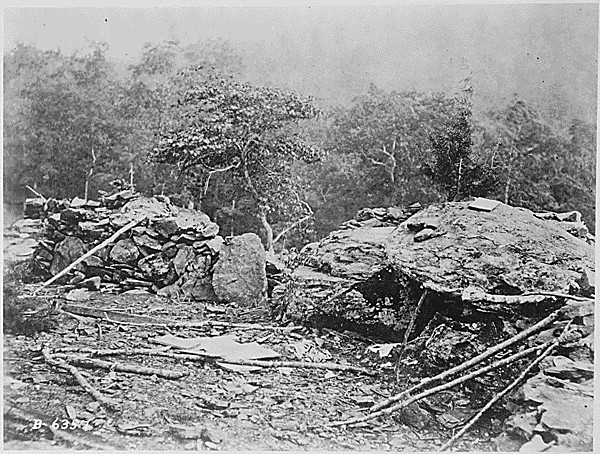
Little Round Top Union Breastworks (Source: The National Archives) Brady
Each July we bring out the film Gettysburg and watch it in a couple of sittings. (My husband can’t wait for the four plus hour epic to come out in Blu-ray.)
I’ll be the first to admit that it’s more than a bit hokey here and there but the scene of the defense of Little Round Top by the 20th Maine Volunteer Infantry Regiment is always a highlight.
My current reading for class discusses the legacy of bayonet charges from the Mexican War and the debate over the frequency of their use during the American Civil War still goes on. Undebatable is the inspired use of a downhill bayonet charge by Col. Joshua Lawrence Chamberlain and its standing on the list of well-known actions at Gettysburg.
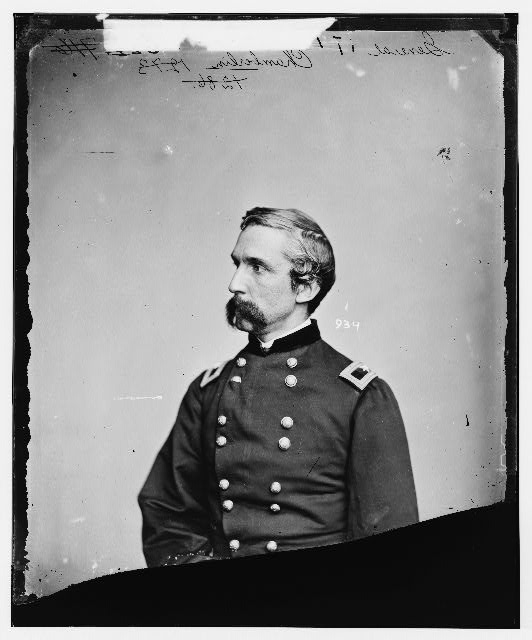
Joshua Lawrence Chamberlain
I’ve been enjoying the perspectives of several ACW bloggers on their top ten books on Gettysburg which Brett over a TOCWOC has nicely organized for us here.
Check them out. Very much worth perusing.
On Military Preparedness and Cartography during the American Civil War
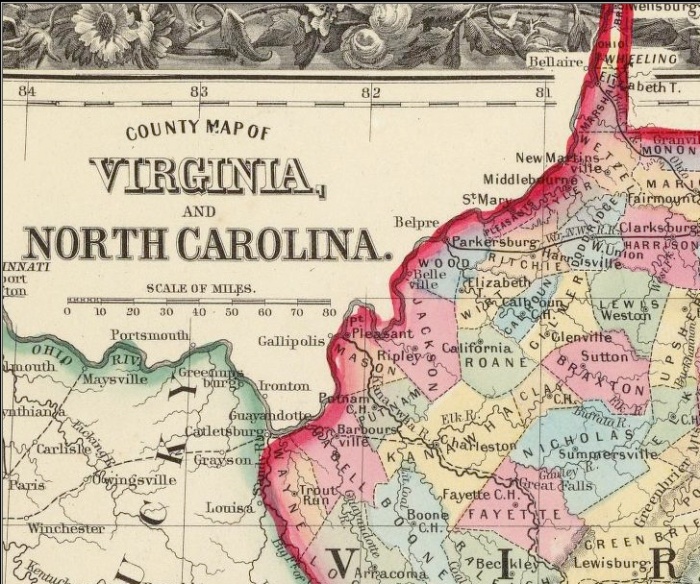
County Map Of Virginia, and North Carolina. 23. Entered ... 1860, by S. Augustus Mitchell, Jr. ... Pennsylvania, Source:David Rumsey Map Collection http://www.davidrumsey.com
From class reading several weeks ago, I thought I would share a fascinating quote from T. Harry Williams and his 1952 work Lincoln and His Generals discussing the military preparedness of both sides to wage the war between the states.
“All of them were unready for war in 1861, and in that year and even later were not able to furnish field commanders with the technical information or advice or supplies which they were suddenly called on to provide. One of the most ironic examples of American military unreadiness was the spectacle of Northern – and Southern – generals fighting in their own country and not knowing where they were going or how to get there. Before the war the government had collected no topographical information about neighboring countries or even the United States, except for the West. No accurate maps existed. General Henry W. Halleck was running a campaign in the western theater in 1862 with maps he got from a book store.”
By the way, I highly recommend the David Rumsey Map Collection site available here. Outstanding collection of maps and the user interface is superb!
Attack and Die

Confederate Dead, Spotsylvania Court House, Virginia
Currently reading… Attack and Die: Civil War Military Tactics and the Southern Heritage by Grady McWhitney and Perry D. Jamieson. Incredible statistics describing the carnage resulting from Confederate offensives against fortified positions.
Photo of Lt. General Grant’s Fascinating Staff at Center Point, Virginia
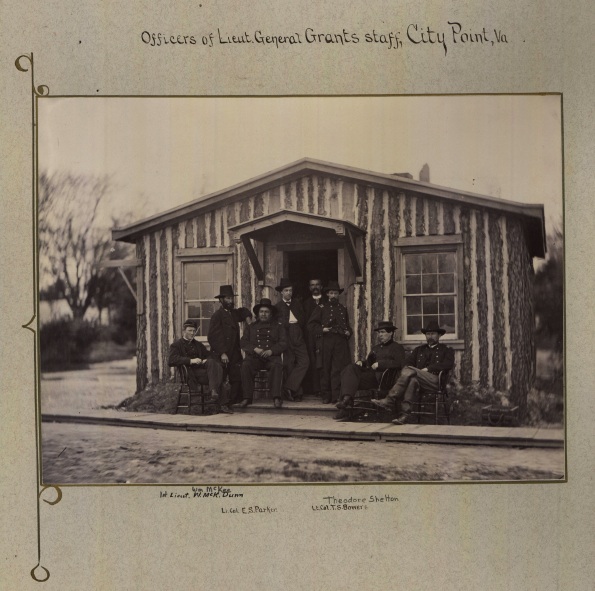
I ran across this excellent photo of Grant’s staff pictured below in City Point, Virginia on the Army Heritage Collection Online site. According to the writing on the matting, included are: 1st Lieut. William McKee Dunn, Jr. (seated left), Lt. Col. E. S. Parker (larger man seated to left of door), and Lt. Col. Theodore Shelton Bowers (standing to right of door). That accounts for only three of the eight men pictured although it’s unclear whether all of the men are in the military. A very similar photo appearing in the book, The Life of General Ely S. Parker, indicates that the building pictured was the headquarters of the Army of the Potomac and was taken in 1864 by legendary Civil War photographer Mathew B. Brady. (1) This would have been one of 22 log cabins that were built to house Grant and his staff and formed the headquarters on the James River. Originally quartered in tents, as the siege of Petersburg extended and the weather deteriorated, Grant had the cabins erected. His cabin had two rooms, one in the front for carrying on war matters and a room at the rear for his quarters. I am unsure whether this is Grant’s cabin. The town is known today as Hopewell. (2)
William McKee Dunn, Jr.: Undoubtedly the youngest of the men pictured, Dunn joined the army at age 18 as a private and became an aid-de-camp to General Sullivan in March of 1863 and then to Grant in October of the same year. He served with Grant through the rest of the war eventually being promoted to captain. Sources indicate that he had occasional charge of Grant’s son Jesse. (3)
Ely Samuel Parker: A highly educated Seneca Indian, Parker was refused entry to the bar and initially entry to the Union Army because of he was not considered an American citizen. He was trained as an engineer and became friends with Grant prior to the war. Grant brought him to his staff at Vicksburg. On August 30 1864, he was officially appointed as Grant’s private secretary by General Order No. 249. Parker eventually rose to the rank of Brevet Brigadier General. He was frequently referred to as simply “the Indian.” (1) His biography is available on Google Books here.
Theodore. Shelton Bowers: On March 8, 1866, the New York Times reported the horrific death of then General T. S. Bowers in an accident while attempting to jump on to the rail car carrying Grant after the party dropped Grant’s son at West Point. You can read that account here. (4)
Sources:
1 The life of General Ely S. Parker: Last Grand Sachem of the Iroquois and Grant’s Military Secretary, Arthur Caswell Parker, (Buffalo, New York: Buffalo Historical Association, 1919).
2 Grant’s Headquarters, a site maintained by the National Park Service accessed on June 28, 2009 here.
3 William McKee Dunn by William Wesley Woolen, (Knickerbocker Press: New York), 93 – 94, accessed online on Google books here, June 28, 2009.
4 “Particulars of the Death of Gen. T. N. Bowers,” New York Times, March 8, 1866, accessed online here, June 28, 2009.
Up this Week: Battle Tactics of the Civil War
Up this week: Chapters 1 – 6 of Paddy Griffith’s Battle Tactics of the Civil War. Mr. Griffith was a lecturer at the Royal Military Academy Sandhurst.
- Published on: 2001-03-01
- Publisher: Yale University Press
- Original language: English
- Binding: Paperback
- 240 pages
Epiphany – The Industrial Revolution and the Civil War
T. Harry Williams’ essay, “The Military Leadership of North and South” in the book Why the North Won the Civil War is outstanding.
His point that the Industrial Revolution had the “immediate consequence of making the Northern generals less inclined to deal out destruction” was an epiphany. So much of what I’ve read until now points to the advantages of the North because of more and better “everything.” That this affluence in war-making capacity contributed to the early lack of engagement of the North’s generals now makes perfect sense.
“They could secure material so easily that they refused to move until they had received more than they needed — after which they were often so heavily laden the could not move.” (Williams, 50 – 51)
Likewise, the “poverty of Southern resources” explains the scrappy nature of the generals of the Confederacy.
The lesson is timeless and as important to business – my field of battle – as the military.
Excellent Description of the 2nd Battle of Corinth in “The State of Jones”
In June 6th’s post I mentioned I was reading a review copy of The State of Jones: The Small Southern County That Seceded from the Confederacy by Sally Jenkins and John Stauffer. This update: their description of the Battle of Corinth is outstanding, albeit gruesome. I will file the book in numerous places on my virtual bookshelves as it covers a great deal of ground: the experience of soldiers, rich versus poor in the military of the Confederacy, unionists in the South, the experience of slaves, etc., etc.

This sample of the telling of the Battle of Corinth…
“[Brigadier General Martin] Green ordered the men forward. ‘With a wild shout,’ the Mississippians leaped across a railroad cut with the rest of the brigade. A command came to charge at the the ‘double-quick.’
It was the last order that could be heard, as at least fifty Federal guns opened fire on them. the trembling thunder of artillery was joined by the shrieking, concussive outbursts of shells and the short, almost muffled spat-spat-spat of Springfield rifles, hammers hitting soft gunpowder, followed by the metallic raking of ramrods. ‘The very atmosphere seemed filled with shot, shell, grape and canister,’ General Green reported.
Suddenly it seemed as if they were in a rainstorm of blood. Horses plunged and caterwauled, and men screamed incoherently. There was something about such a charge that forced the breath from men’s throats, almost reflexively, without their even knowing it. As one Mississippi soldier recorded in his diary, ‘I always said, if I ever went into a charge, I wouldn’t holler. But the very first time I fired off my gun, I hollered as loud as I could, and I hollered every breath until I stopped!” (p. 33)
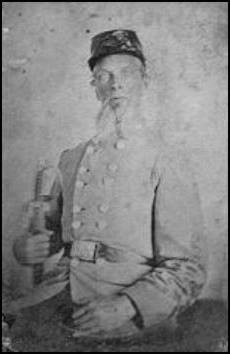
Brig. Gen. Martin E. Green
Maj. Gen. Earl Van Dorn (Army of West Tennessee) was later court-marshaled for his neglect in taking care of logistical details and forcing his army to march and fight the Battle of Corinth with insufficient water and food. The charges were dropped.

Maj. Gen. Earl Van Dorn
The State of Jones
The good folks at Doubleday sent me a review copy of The State of Jones: The Small Southern County That Seceded from the Confederacy by Sally Jenkins and John Stauffer. It is available for pre-order now from WigWags Books and will be published on June 23rd.
- Hardcover: 416 pages
- Publisher: Doubleday (June 23, 2009)
- Language: English
- ISBN-10: 0385525931
- ISBN-13: 978-0385525930
- Dimensions: 9.5 x 6.4 x 1.2 inches
This is the story of Newton Knight who was a Unionist living in Mississippi and strongly anti-slavery. The authors suggest that he was “the South’s strangest soldier.”
Some quick facts:
- In Jones County Mississippi, fifty-three men had not only fought as anti-Confederate guerrillas, but formally enlisted in the Union army in New Orleans
- Knight’s group of guerrillas “remained unconquered though surrounded by Confederate Armies from start to finish.”
- Jones was drafted into the Confederate army but refused to fight and eventually deserted.
- Knight had two families, one white and one black. His black family was with a slave named Rachel who was owned by his family and who helped him during the war. He acknowledged her children as his own.
I profess to getting behind in my reading for school because of this book. I promise to write a proper review after I’m finished reading it. I can say that it is VERY well written.
Newton Knight’s story is being made into a film currently in production. Filmmaker Gary Ross is writer, director, and one of several producers.
Sally Jenkins is an award-winning journalist currently with the Washington Post. She has authored eight books, three of New York Times bestsellers.
![]()
John Stauffer is Professor of English and African American Studies and Chair of the Committee on Higher Degrees in the History of American Civilization at Harvard. ![]()
His prior book, GIANTS: The Parallel Lives of Frederick Douglass and Abraham Lincoln, I mentioned in a previous post which you can read here. 
Informal Leadership and Civil War Command
I’m reading the second half of Archer Jones’ Civil War Command and Strategy: The Process of Victory And Defeat this weekend. He makes an interesting point about the power of informal leadership over formal leadership positing that people find informal leaders just as they create informal organizations. He suggests that George McClellan provides one of the best examples.
As the creator and first commander of that Army [the Army of the Potomac], he had claims to loyalty which his charisma and the appeal of his Peninsula campaign’s strategy intensified. Even after he had left the command, his position of formal leadership, he continued to exercise great informal influence. This often took the form of the officers of the Army of the Potomac displaying hostility to the secretary of war and an unshakable allegiance to the strategy of the Peninsula campaign. No successor in command could ever displace him as the army’s informal leader, a situation which made it difficult for every subsequent commander and limited the ability of the president ad the general in chief to enjoy any widespread, deep-rooted support.
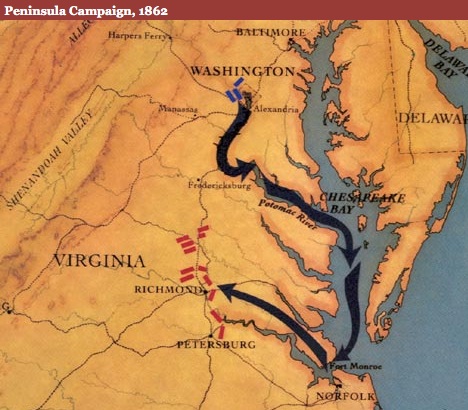
Source: PBS: http://www.pbs.org/civilwar/war/map3.html#
 In like fashion, he suggests that Lee uprooted Johnston’s memory because of the three campaigns he conducted in four months and put Lee in the position of informal and formal leader of the Army of Northern Virginia.
In like fashion, he suggests that Lee uprooted Johnston’s memory because of the three campaigns he conducted in four months and put Lee in the position of informal and formal leader of the Army of Northern Virginia.
Do you agree with his assessment?
 Archer Jones, Civil War Command and Strategy: The Process of Victory And Defeat, (New York: The Free Press, 1992), 126.
Archer Jones, Civil War Command and Strategy: The Process of Victory And Defeat, (New York: The Free Press, 1992), 126.
Kindle 3 DX Announced! Yes I’ve Pre-ordered Mine
Publishers. Are you listening?
Many of you know that I was pretty excited about my Kindle 2. See all my previous posts on it here. This week, Amazon.com announced that they will release the new Kindle 3 DX this summer which has a larger form factor (9.7-inch diagonal screen). Other key enhancements include the following:
- More storage – 3,500 hundred books instead of 1,500 on the Kindle 2
- Native PDF reader on board where as the Kindle 2 required conversion
- Accelerometer on board which is the technology that causes the screen to move from portrait to landscape when you rotate the device 90 degrees. VERY COOL! I believe Amazon refers to the feature as an “Auto-Rotating Screen.”

The DX using the same electronic-ink technology that prints digitally to the screen and is amazingly readable. Images are even more incredible to view than text. And it uses the super fast Sprint national high-speed (3G) data network that Amazon refers to as Whispernet (at no CHARGE!).
Man I wished I had had this when I was in engineering school. You try carrying a ginormous calculus textbook that covers Calc I, II, and III, physics for engineering book, chemistry, statics, and all the lab books around all over campus in a backpack!
Great for work, school, and pleasure. Highly recommend.
Taming Democracy: “The People,” the Founders, and the Troubled Ending of the American Revolution
I was delighted to find a package from Oxford University Press waiting at my door this afternoon and in it was a review copy of the new paperback edition of Terry Bouton’s Taming Democracy: “The People,” the Founders, and the Troubled Ending of the American Revolution. This looks to be a fascinating read, one that presents a more accurate picture of the founding fathers and the common man of the era.
This from the pre-publicity…
The Founding Fathers are generally considered the most highly regarded Americans in the history of our country; celebrated as the brave and noble group of visionaries who banded together to overthrow the British and bring democracy to the land. Yet what if, contrary to popular belief, these fondly remembered individuals weren’t the great purveyors of freedom for all that we accept them to be?
Taming Democracy devotes much of its pages to the ordinary citizens who protested against the Founding Fathers’ hypocrisy. Common citizens of all back grounds did everything from run for political office to organize political parties and uprisings against what they labeled “united avarice” controlled by “moneyed men.”
It’s worth noting that this book was recipient of the Philip S. Klein Book Prize of the Pennsylvania Historical Association and received Honorable Mention, Fraunces Tavern Museum Book Award.
 Terry Bouton is Associate Professor of History at the University of Maryland, Baltimore County and holds a PhD from Duke University. His homepage at the university can be accessed here.
Terry Bouton is Associate Professor of History at the University of Maryland, Baltimore County and holds a PhD from Duke University. His homepage at the university can be accessed here.
- TAMING DEMOCRACY: “The People,” the Founders, and the Troubled Ending of the American Revolution
- Author: Terry Bouton
- Publisher: Oxford University Press
- Published on March 19, 2009
- 332 Pages
- Paperback
- ISBN13: 9780195378566
- Price: $21.95
This just in – Amazon Kindle for iPhone Application

Amazon hit my mailbox with their announcement about the launch of a Kindle application for the iPhone and iPhone Touch. This effectively makes available to iPhone users the 240,000 books currently in the Kindle Store. I know my previous posts on my new Kindle 2 (see below) generated a lot of discussion so I’ll be interested in whether any of you iPhone users plan to give this a try. I have an iPhone Touch and will give it a go myself. I’ve heard some of you say that you have some challenges reading books on your iPhone so will be interested in your thoughts. I’m assuming the size factor is one of the key issues.
Of note, I’ve read posts around the net about rumors of a larger Kindle targeted toward the student market. I’ve heard it would be 81/2 by 11 inches and thus perfect for textbooks and storing school documents or journal reading assignments. VERY COOL if it happens. The Kindle 2 missed some rumored launch dates so rumors are rumors.
The folks at Oxford University Press seem to be jumping on the Kindle bandwagon. As I mentioned in my post titled Copperheads: The Rise and Fall of Lincoln’s Opponents in the North, Weber’s book is available in a Kindle version. Also, their dictionary is preloaded on Kindle 2 and can provide word-by-word definitions at the bottom of the page as you read through a book if you so desire.
It will be interesting to see if Amazon will port their application to other phones and networks in the near future. Sprint’s Instinct, HTC Touch, and the upcoming Palm Pre (I want one) would seem to be excellent options.
What this does signal is another way to quickly download, carry, and read not only books in print but the myriad of “public domain” documents available, many being primary source material. See my previous post here on just a few of those titles already loaded on Amazon for download at either no charge or minimal charge that should be of interest to those into 19th century American and / or the American Civil War.
Here are quick links to the previous posts on Kindle 2. I recommend, if you are intrigued and considering a Kindle 2, that you read the comments.
My New Kindle 2
More on My New Kindle 2
WOW – This just In! Kindle Store has 7000 Public Domain Books including Civil War Memoirs
Free or Inexpensive American Civil War Titles for Kindle
Copperheads: The Rise and Fall of Lincoln’s Opponents in the North
The good folks at Oxford University Press have sent me a review copy of Jennifer L. Weber’s book, Copperheads: The Rise and Fall of Lincoln’s Opponents in the North. I’m very much looking forward to reading Weber’s work as it addresses the political war that was in play during the American Civil War in the North. This quick excerpt from the back jacket gives a taste of the ferocity of that conflict.
The Northern home-front during the Civil War was far from tranquil. Fierce political debates set communities on edge, spurred secret plots against the Union, and triggered widespread violence. At the heart of all the turmoil stood the anti-war Democrats, nicknamed “Copperheads.” Now, Jennifer L. Weber offers the first full-length portrait of this powerful faction to appear in almost half a century. Weber reveals how the Copperheads came perilously close to defeating Lincoln and ending the war in the South’s favor.
Note that James M. McPherson provides the foreword.
 Dr. Weber is an Assistant Professor with the Department of History at Kansas University and you can see her profile on the campus site here. Oxford University Press provides an online Q & A with Dr. Weber on her book here.
Dr. Weber is an Assistant Professor with the Department of History at Kansas University and you can see her profile on the campus site here. Oxford University Press provides an online Q & A with Dr. Weber on her book here.
- Hardcover: 304 pages
- Publisher: Oxford University Press, USA (October 9, 2006)
- Language: English
- ISBN-10: 0195306686
- ISBN-13: 978-0195306682
- Product Dimensions: 9.3 x 6.4 x 1.1 inches
- Note that this book is also available in a Kindle edition.
The Last Confederate General: John C. Vaughn and His East Tennessee Cavalry
The good folks at Zenith Press have sent me a review copy of The Last Confederate General: John C. Vaughn and His East Tennessee Cavalry by Larry Gordon which I’m very much looking forward to reading and reviewing. A perusal of the book shows a significant set of reference notes and a strong bibliography both of which I always appreciate. More to come.
- ISBN-13: 9780760335178
- Published on: 2009-03-15
- Original language: English
- Binding: Hardcover
- Dimensions: 5.5 x 8.5
- 272 pages
The bronze memorial below is found at Vicksburg National Military Park. It was sculpted by T.A.R. Kitson, erected in 1911 and is located 75 yards west of the Tennessee State Memorial on North Confederate Avenue.
You can read some of the official documents authored by Vaughn here.
WOW – This just In! Kindle Store has 7000 Public Domain Books including Civil War Memoirs
So in my last post, I was saying you could get public domain books to your Kindle for 10 cents if you wanted to find them and upload them for conversion by Amazon and send to you wirelessly. I just found a terrific Kindle Blog that has the following post that indicates that in late January, Amazon loaded 4700 Public Domain Books to their Kindle Store. This saves the hassle of uploading. The post on February 7 indicates that there are 7000 Public Domain books available on the site now. Amazing!
So I just went out to the Kindle Store. Remember that Phil Sheridan’s Memoir that I uploaded and then crossloaded? It was already there on the Kindle store for free broken into parts.
Check it out here.
Grant’s Memoirs are also there.
I “bought” (for zero dollars) both memoirs and seven volumes of The World’s Greatest Fiction. All of these were downloaded and ready for me to read within less than 20 seconds.
Wow…
E. L. Doctorow’s The March and The Whiskey Rebels: A Novel by David Liss
Two new fiction works have made their way to my library. The March by E. L. Doctorow. This book was required reading for the Yale course by David W. Blight on the Civil War era which I mentioned here. I picked up a nice hardback used and am listening to it on my MP3 via download from the library.
- Author: E. L. Doctorow
- Hardcover: 363 pages
- Publisher: Random House (September 20, 2005)
- Language: English
- ISBN-10: 0375506713
- 384 pages
Second, I have The Whiskey Rebels: A Novel by David Liss which I ordered on my new Kindle 2 only. I may pick up a used copy at some point. As I mentioned in my post on the Kindle, I can also listen to The Whiskey Rebels: A Novel via text-to-speech capabilities on the Kindle.
- Author: David Liss
- Format: Kindle Edition
- Publisher: Random House; 1 edition (September 30, 2008)
- Language: English
- ASIN: B0015DYJVW
- File Size: 443 KB
- Print Length: 544 pages
Finally! Tocqueville’s Democracy in America
I have finally purchased my own copy of Tocqueville’s Democracy in America, as translated by Arthur Goldhammer. Tocqueville’s works rank near the top of the the most frequently quoted in a great many of the books I’ve been reading this term and in previous terms for that matter. I decided on The Library of America version because, as was the case with my purchase of Frederick Douglass Autobiographies (see post here), I like the look and feel.
You can read some of Tocqueville’s work, including both volumes of Democracy in America at Project Gutenberg here.

Alexis De Tocqueville
Yale’s David W. Blight Lectures on the Civil War Era Online at Academic Earth
A friend tipped me off on Friday to a EXCEPTIONAL site, AcademicEarth.org, which provides free audio-visual lecture series of some of the world’s best scholars.
David W. Blight’s entire Spring 2008 term course, The Civil War and Reconstruction Era, 1845-1877, is online for free viewing. Professor Blight is the Class of 1954 Professor of History at Yale University and Director of the The Gilder Lehrman Center for the Study of Slavery, Resistance, and Abolition, also at Yale University.
In addition to the course, presented in an extremely user friendly format, Academic Earth provides a syllabus, reading list (yes I’ve already ordered them all), and full text transcripts of all lectures. GOLD MINE.
I’ve made it through 13 of 27 lectures and they are both outstanding and mesmerizing. HIGHLY RECOMMEND!
IUP Civil War and Lincoln Book Sale – Dude!
If you hadn’t noticed, I am a hopeless book acquirer. But, like most folks, I am watching my book budget these days. That said, I found a sale going on this month over at Indiana University Press that has some awesome deals. To commemorate the Lincoln Bicentennial, they’ve put books on sale about both Lincoln and the Civil War.
There are some serious deals over there. Example: One of my favorite books, The American Civil War and the Origins of Modern Warfare by Edward Hagerman – FIVE BUCKs. And FREE SHIPPING – if you buy $25 or more (I discovered). I couldn’t help myself and didn’t have any trouble making the $25 threshold.
Note to self. Buy more bookshelves.
OUP Blogs Lincoln as Part of Bicentennial Celebration

I’m a fan of university presses so I’m sharing some information forwarded to me by the good folks at Oxford University Press about books and stories they are featuring on their Oxford University Press USA Blog as part of the Lincoln Bicentennial celebration. Check it out.
- An excerpt from James McPherson’s ABRAHAM LINCOLN
- A series of FAQ’s with Allen Guelzo author of LINCOLN: A Very Short Introduction
- A look at how Lincoln almost failed by Jennifer Weber author of COPPERHEADS: The Rise and Fall of Lincoln’s Opponents in the North
- A post by Lincoln Prize Winner Craig L. Symonds comparing Lincoln and Obama which you can view here.
The Invention of Party Politics Requires a Page of Its Own
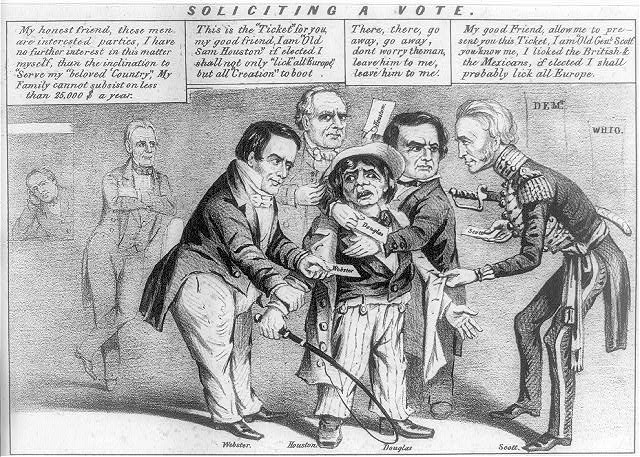
"Soliciting a Vote" Probably drawn by John L. Magee. Source: RN: LC-USZ62-14075 Repository: Library of Congress Prints and Photographs Division Washington, D.C. 20540 USA http://hdl.loc.gov/loc.pnp/p.print
Studying Antebellum America, as I’m doing this term, provides a fascinating look at the development of the notion of “political parties.” Keeping track of all of the political groups in Antebellum America has become a challenge. I need a list or a matrix. That said, I’ve decided to build a new page called “The Political Groups.” The only content so far is as follows but I’ll be adding over time.
Federalists, Silver Grays, Whigs, Democrats, Free Soil Party, Unionists, Liberty Party, Know Nothings (American Party), American Republicans, Anti-Masonic
To all of my readers, your input on information, books, and links to good sites with information on 19th century political groups before, during, and after the American Civil War will all be enthusiastically received. The list above should not be in any way construed as complete. State as well as national parties are game.
By the way, there is an interesting book I’ve run across on the subject, The Invention of Party Politics: Federalism, Popular Sovereignty, and Constitutional Development in Jacksonian Illinois, by Gerald Leonard, University of North Carolina Press, 2002. 328 pgs. I’ve quoted Mr. Leonard in at least one of my posts this term: On Slavery, Sectionalism, and the First and Second Party Systems here.
To house this an other books on the topic, I’ve added a page titled Political Groups to my virtual bookshelves here. I’ve remapped some of the books on the Antebellum America shelf to this one as well since the topics overlap.
Leonard provides an outstanding list of books and articles on this topic in his bibliography. Some I own including both of Holt’s books: The Political Crisis of the 1850’s and The Rise and Fall of the American Whig Party, and thanks to reader elektratig, Nativism and Slavery: The Northern Know Nothings and the Politics of the 1850s, by Tyler G. Anbinder 9See earlier post on Anbinder’s book here). Others, I’d like to obtain. I may load the entire bibliography to my virtual bookshelves over time as reference and have started that effort here. It’s a long and fantastic list so will take some time.
About the Image: “A cynical view of party competition for the working man’s vote in the presidential campaign of 1852. In a polling place, four candidates struggle to force their own election ticket on a short, uncouth-looking character in a long coat. The latter holds a whip, suggesting that he is either a New York cabman or a farmer. The candidates are (left to right): Whig senator from Massachusetts Daniel Webster, Texas Democrat Sam Houston, Illinois Democrat Stephen A. Douglas, and Whig general Winfield Scott. The cartoon must have been produced before the June 5 nomination of dark-horse Franklin Pierce as the Democratic candidate, as Pierce is not shown. Webster: “My honest friend, these men are interested parties, I have no further interest in this matter myself, than the inclination to ‘Serve my beloved Country,’ My Family cannot subsist on less than 25,000 $ a year.” His comment may refer to his own personal financial straits or to the nepotism involved in securing his son Fletcher’s lucrative appointment as surveyor of the Port of Boston in 1850. Scott (in uniform, grasping the man’s coat): “My good Friend, allow me to present you this Ticket, I am ‘Old Genl. Scott’ you know me, I licked the British & the Mexicans, if elected I shall probably lick all Europe.” Houston: “This is the ‘Ticket’ for you, my good friend, I am ‘Old Sam Houston’ if elected I shall not only ‘lick all of Europe,’ but all ‘Creation’ to boot.” Douglas (his arms around the man): “There, there, go away, go away, don’t worry the man, leave him to me, leave him to me.” Affixed to the wall at right are two posters or signs marked “DEMT.” and “WHIG.” In the left background stands Henry Clay leaning against a chair observing the scene, along with President Millard Fillmore who looks in through a window.”
Quoted from the Library of Congress.
Just Arrived! Defiant Peacemaker: Nicholas Trist in the Mexican War
The good folks at Texas A&M University Press have sent me a review copy of Wallace Ohrt’s work, Defiant Peacemaker: Nicholas Trist in the Mexican War which arrived this week. I ran into Nicholas Trist in this semester’s reading and found him a fascinating albeit almost forgotten character. Highly principled, he sacrificed his entire career to negotiate the Treaty of Guadalupe Hidalgo, and defied a U.S. president to do it. The result was an end to the Mexican War and the acquisition of the Southwest.
From all I’ve heard, this is an excellent read and can’t wait. More to come.
Defiant Peacemaker: Nicholas Trist in the Mexican War
ISBN: 0-89096-778-4
Published on: 1998-01
Original language: English
Binding: Hardcover
190 pages
New Additions: Writing the Civil War and New Shelves at WigWags Books
My copy of Writing the Civil War: The Quest to Understand arrived this week. Thanks to Daniel Sauerwein, a fellow WordPress blogger over at Civil War History for the recommendation. Published by the good folks at University of South Carolina Press, it is edited by James M. McPherson and William J. Cooper, Jr. Contributors include:
- Michael Les Benedict
- Drew Gilpin Faust
- Gary W. Gallagher
- Joseph Thomas Glatthaar
- Michael F. Holt
- Peter Kolchin
- Reid Mitchell
- Mark E. Neely, Jr.
- Philip Shaw Paludan
- George C. Rable
- James L. Roark
- Emory M. Thomas
Note: I’ve put up new bookshelves over at WigWags Books and have begun adding links to my – no kidding – MANY books on writing. It will take me some time to get them all added. That said, there is a new shelf titled specifically, “Writing – Civil War” on which I’ve placed the book above. Please let me know if you’re aware of others in this category.
Finally, I’ve added a new icon/picture to the write navbar of WigWags on which you can click to be directed to books on my bookshelves. This is an actual image of just a few of the books on my home bookshelves. You’ll find the new icon right under the title,
Find books on my bookshelves at WigWags Books
New Acquisition – Fredrerick Douglass Autobiographies
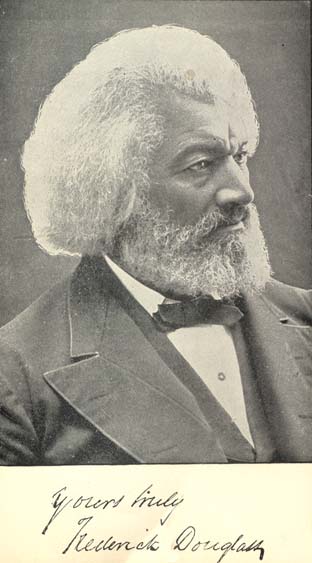
My study of Antebellum America this term has revealed a significant gap in my library. That has been filled with the arrival this week of Frederick Douglass: Autobiographies. I purchased The Library of America edition. I like the look and feel.
It includes three works:
- Narrative of the Life of Frederick Douglass, an American Slave
- My Bondage and My Freedom
- Life and Times of Frederick Douglass
From historian Bruce Levine,
“Frederick Douglass’s magnificent autobiography, The Life and Time of Frederick Douglass is indispensable.”
I look forward to getting to know this important American.
Bruce Levine, Half Slave and Half Free: The Roots of Civil War, Revised (Hill and Wang: New York, 2005), 264.
Next Course – Civil War Strategy and Tactics
I just registered for my next course, Civil War Strategy and Tactics, which will start March 2nd. Book list looks terrific and is on order. It’s also loaded on my virtual bookshelves which you can access by clicking on any of the books. I’ve updated “the courses” page here.
Course Description: This course is a study of the American Civil War with emphasis on operational contributions of Union and Confederate military leadership. Students examine Civil War battles on two levels: the strategic doctrine as formed by the major commanders and tactical developments that affected the conduct of battle at a lower echelon of command. Special emphasis is on the interplay between these levels in order to gain a comprehensive view of strategy and tactics in both armies from 1861-1865.
New Acquisition: Nativism and Slavery: The Northern Know Nothings & the Politics of the 1850’s
My copy of Tyler Anbinder’s Nativism and Slavery: The Northern Know Nothings & the Politics of the 1850’s finally arrived yesterday. One of my readers recommended it as one of the best resources on the Know Nothings Party which I’ve just finished a series of posts on. Can’t wait to dig in.
ISBN13: 9780195089226
ISBN10: 0195089227
Paper, 352 pages
Oxford University Press
Published: May, 1994
Winner of the Avery O. Craven Award of the Organization of American Historians
New York Times 1992 Notable Book of the Year
Chosen by The Gustavus Myers Center as a 1992 Outstanding Book on Human Rights in the United States Outstanding Book on Human Rights
 Dr. Anbinder is chair of the Department of History at The George Washington University. You can view his complete C.V. here.
Dr. Anbinder is chair of the Department of History at The George Washington University. You can view his complete C.V. here.
Political History Word of the Day – Jingoistic
 I ran across the word “jingoistic” tonight in my reading of a fascinating book, The Party Of Fear: The American Far Right from Nativism to the Militia Movement by David H. Bennett.
I ran across the word “jingoistic” tonight in my reading of a fascinating book, The Party Of Fear: The American Far Right from Nativism to the Militia Movement by David H. Bennett.
jingoistic
adjective
fanatically patriotic [syn: chauvinistic]
jin·go·ism
Extreme nationalism characterized especially by a belligerent foreign policy; chauvinistic patriotism.
jin’go·ist n., jin’go·is’tic adj., jin’go·is’ti·cal·ly adv.
Here is a snippet from Bennett’s book to show the context of his use of the word.
The greatest upheaval was the clash between the North and South. The issue of slavery, and the sectional conflict it helped to generate and exacerbate, was inextricably connected to territorial expansion. The Missouri Compromise of 1820 temporarily resolved that issue, setting the famous line (36° 30″) to the Pacific, north of which the South’s “peculiar institution” could not be extended. But the question flared anew with the Mexican War and the prospect of a rich California territory and a new estate in the desert and mountain West available for American settlement and development. This war of expansion did not unify the country as have international conflicts in some tranquil times. Nor did that other jingoistic outburst against the British in the debate over division of the Oregon territory in the far Northwest. (2)
(1) jingoistic. Dictionary.com. The American Heritage® Dictionary of the English Language, Fourth Edition. Houghton Mifflin Company, 2004. http://dictionary.reference.com/browse/jingoistic (accessed: December 20, 2008)
(2) David H. Bennett, The Party Of Fear: The American Far Right from Nativism to the Militia Movement [book on-line] (Chapel Hill, NC: University of North Carolina Press, 1988, accessed 20 December 2008), 95; available from Questia, http://www.questia.com/PM.qst?a=o&d=105437276; Internet.
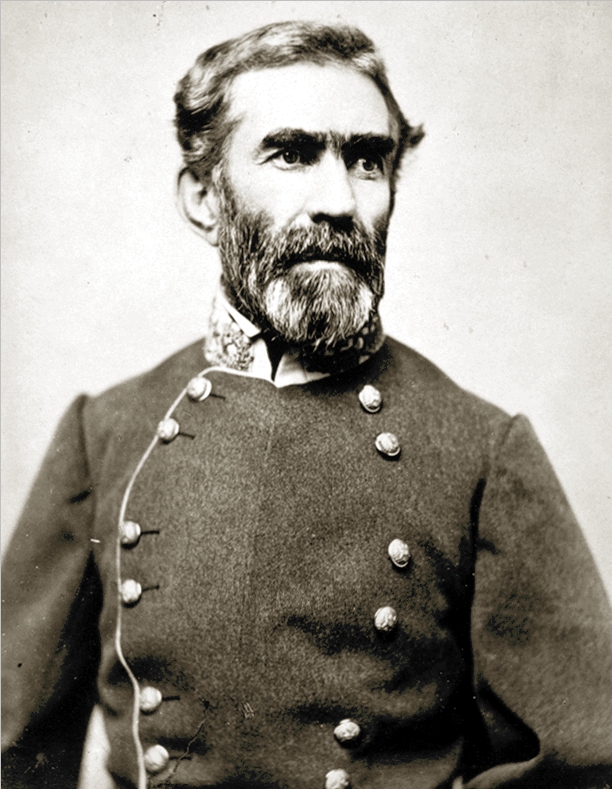
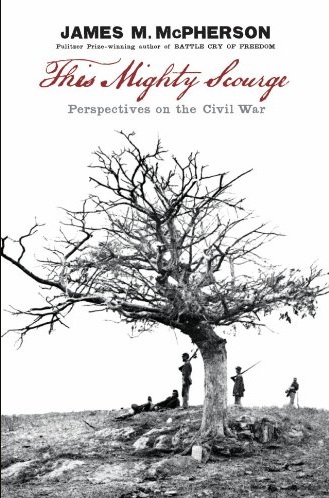

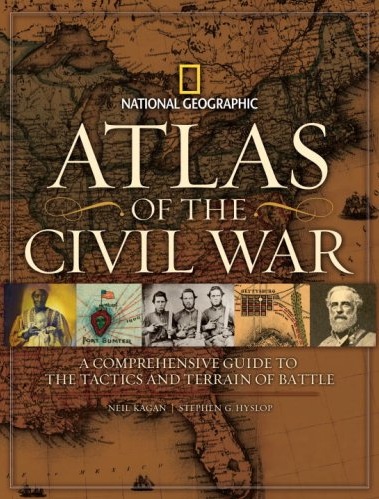
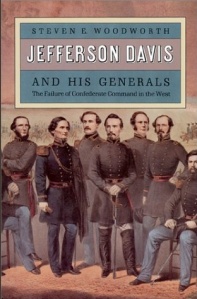
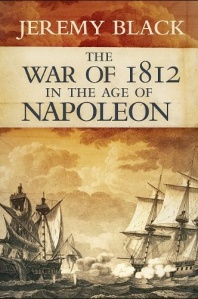
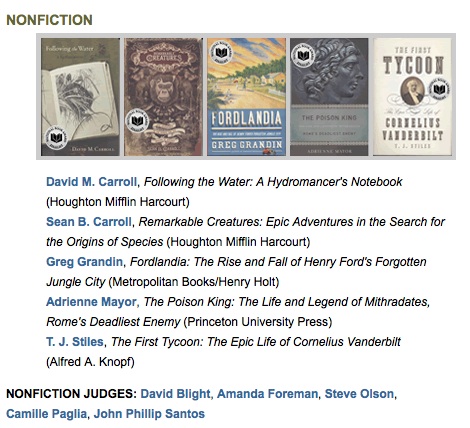
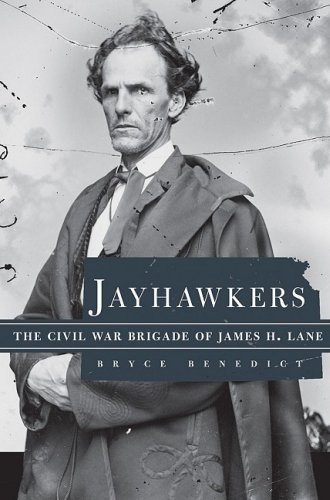
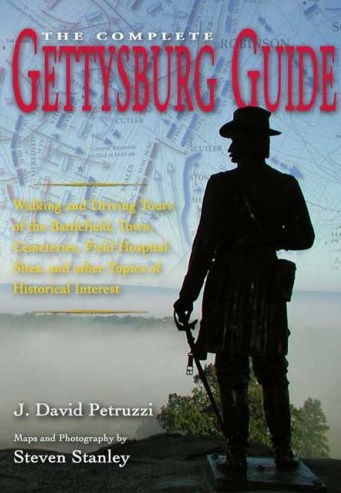
![the-fight-between-the-alabama-and-the-kearsarge-nh59354 "The Fight Between the Alabama and the Kearsarge" [NH59354]](https://wigwags.files.wordpress.com/2008/09/the-fight-between-the-alabama-and-the-kearsarge-nh59354.jpg?w=700)
